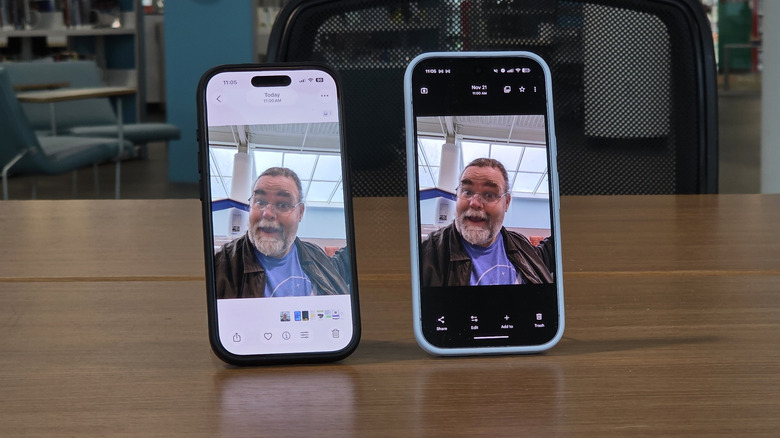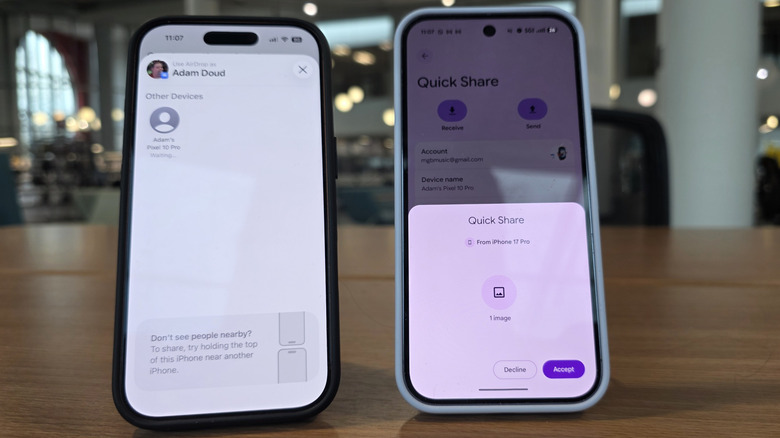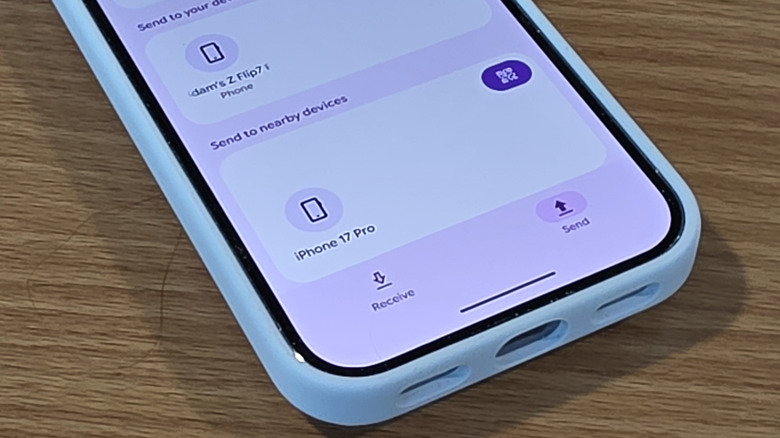Google's AirDrop Move Has Android Users Cheering, But Don't Get Too Comfortable
If you thought the mobile space had no room for surprises anymore, we have news for you. Yesterday, Google announced that it had developed a solution that allows the Pixel 10, both Pixel 10 Pro devices, and the Pixel 10 Pro Fold to communicate and share files with Airdrop on Apple devices. That includes iPhones, iPads, and macOS computers. This is a long-requested feature, and it was met with calls for celebration — and skepticism — by the online community.
Long-time tech YouTuber Andru Edwards said on Threads, "This is huge!" while fellow creator, Michael Fisher, called the move "massive." Other users were quick to join in the praise. One user called it a huge win for Android, adding that Airdrop is a top feature that keeps people on iPhones. Another user indicated that the file transfer is quick and easy and feels like native Airdrop.
Others were quick to point out that this was not done in collaboration with Apple so it's possible Apple may respond by breaking it in some way. To quote YouTuber David Cogen, "It'll be gone in two days," and he's not entirely wrong.
Where did this come from?
When the news initially broke, a few publications speculated as to what was going on here. Ars Technica wrote that it may be related to some EU regulation requiring Apple to adopt an open standard for communicating between two devices. The Verge, meanwhile, guessed that Google most likely "hacked" the solution, citing a number of quotes from Google along the way — quotes that a Google spokesperson gave to us as well.
"We accomplished this through our own implementation. Our implementation was thoroughly vetted by our own privacy and security teams, and we also engaged a third party security firm to pentest the solution."
When we asked whether this solution piggy backed on the EU/open standard suggested in the Ars piece, we were simply told "no." Meanwhile, Pixel pundit C. Scott Brown has a more interesting theory: "I think what Google is saying is, 'Guess what Apple, you're either going to have to accept this or reject it, but if you do, the EU is probably going to have something to say about that because the EU doesn't like the fact that these two phones don't interoperate together.'"
Good news and bad news
Brown is definitely onto something here, and it doesn't really land quite right with me. Don't get me wrong; I'm happy that this is up and working right now and I'm thrilled that Google is planning on rolling this out to more devices in the future. There aren't any hardware-related reasons why this can't work across the ecosystem of Google devices. But I'm not sure I'm thrilled with how Google went about this.
Put simply, there wasn't any collaboration at all; this is 100% a Google joint. Fine, I like the functionality, but that means that Apple could decide to just break the functionality, and then we're all back to where we started. I get that Apple wants to keep some exclusivity in its features and AirDrop is an arguably great feature. Quick Share, for all the functionality it enables, is not nearly as seamless (though it has slowly gotten better).
Why this can go wrong
Google pulling an end-run around Apple to hack its way into the ecosystem is not ideal. It's a lot like Google trying to bully Apple into adopting RCS messaging — which, to be entirely fair, eventually worked out — mostly. It's true that Apple did finally adopt RCS messaging after years of messaging from Google and public pressure, but it did so in the most minimal way possible. The same is true here.
It's equally likely that Apple just outright breaks the functionality within days, or ignores it and carries on. Neither is ideal because in neither case does Apple actively support the activity nor share it with their audience. It takes two to tango as the saying goes, and a feature like this would make a much bigger splash if iPhone users knew about it too. Plus, who knows what other optimizations Apple might have been able to suggest/integrate had the two companies worked together?
If you were to point out that, historically, Apple doesn't typically work that way, that's fair enough. Maybe this was the only way this would ever happen — again, fair enough. Apple would probably argue that this does not help the company achieve its goals of eventually owning, you know, the world. But what I will find to be the most interesting thing about this whole deal is how Apple ultimately responds.
The ball is in Apple's court
Does Apple go out of its way to break this functionality? Does the company ignore it entirely? If the former, Apple is seen as a petty, vindictive company that puts profit over universal functionality. The Android-toting public won't like it, but since when has Apple ever cared about Android? It certainly will be egg on Google's face, which Apple might enjoy. If the latter, that could be seen as a win for Google, but it doesn't make the feature that much more valuable.
Truth be told, I carry an iPhone all year and most of my photos are taken with an iPhone, but I rarely if ever use AirDrop. As much as people say they're clamoring for this functionality, I'm not in that demographic. It's cool that it works, but I'm not sure it'll move the needle for me — if it sticks around.
For now, I'm glad the feature is here, but I wish we didn't live in a world where two companies have to clash at each other instead of collaborating for the good of everyone. I'm an idealist. But for now the functionality exists, so use it while you can. There is no guarantee it'll still be here tomorrow.




